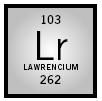Lawrencium

MELTING POINT:
Unknown
BOILING POINT:
Unknown
DENSITY:
Unknown
MOST COMMON IONS:
Lw
3+
Lawrencium is a synthetic radioactive element and the last member of the actinide series. It was discovered in 1961 by Albert Ghiorso and his coworkers, who bombarded a target of isotopes of californium ( 249 Cf– 252 Cf) with boron projectiles (either 10 B or 11 B) using the Heavy Ion Linear Accelerator (HILAC) at the University of California, Berkeley, producing isotopes of unknown element 103 of masses 257 and 258. The atoms recoiling after the nuclear reaction were caught on metalized Mylar tape, which was then moved past a series of α -detectors, and the decays of a few new atoms of element 103 ( 257 103 and 258 103), having half-lives of seconds or less, were recorded. The element is named after Ernest O. Lawrence, the inventor of the cyclotron and the founder of the Berkeley Radiation Laboratory. "Lawrencium" was suggested and accepted by the International Union of Pure and Applied Chemistry, but the originally suggested symbol of Lw was changed to Lr. In 1965 Evgeni D. Donets at the Joint Institutes of Nuclear Research in Dubna, Russia, using a double-recoil technique, confirmed the atomic number of element 103 by linking its decay, via either electron capture followed by α -decay, or α -decay followed by electron capture, to its known granddaughter, an isotope of fermium ( 252 Fm).
All Lr isotopes are radioactive, decaying by α -particle emission, electron capture, and/or spontaneous fission , and have half-lives ranging from a few tenths of a second for the isotope of mass 252, the lightest isotope, to 3.6 hours for the isotope of mass 262, the heaviest. The ground state electronic configuration of the gaseous Lr atom is believed to be [Rn]5f 14 6d7s 2 , by analogy to its lanthanide homologue, lutetium (element 71). Its most stable ion in aqueous solution is Lr 3+ , and attempts to reduce it to Lr 2+ or Lr 1+ in aqueous solution have been unsuccessful.
SEE ALSO Actinium ; Berkelium ; Einsteinium ; Fermium ; Lawrence, Ernest ; Mendelevium ; Neptunium ; Nobelium ; Plutonium ; Protactinium ; Radioactivity ; Rutherfordium ; Thorium ; Transmutation ; Uranium .
Darleane C. Hoffman
Bibliography
Ghiorso, A.; Sikkeland, A.; Larsh, A. E.; and Latimer, R. M. (1961). "New Element, Lawrencium, Atomic Number 103." Physical Review Letters 6:473–475.
Hoffman, Darleane C.; Ghiorso, Albert; and Seaborg, Glenn T. (2000). The Transuranium People: The Inside Story. Singapore: World Scientific Publishing.
Hoffman, Darleane C., and Lee, Diana M. (1999). "Chemistry of the Heaviest Elements—One Atom at a Time." Journal of Chemical Education 76(3):331–347.
Seaborg, Glenn T., and Loveland, Walter D. (1990). The Elements Beyond Uranium. New York: Wiley.
Comment about this article, ask questions, or add new information about this topic: